Family : Camelidae

Text © DrSc Giuliano Russini – Biologist Zoologist

English translation by Mario Beltramini
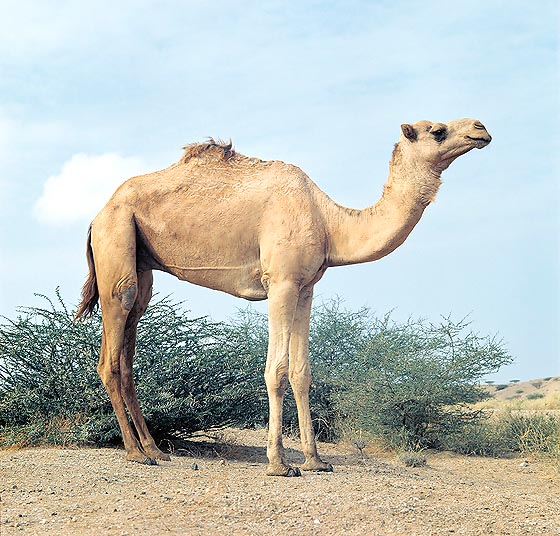
The Camelus dromedarius bears the desert 60°C and big temperature ranges © Giuseppe Mazza
The family of the Camelids (Camelidae), suborder Tylopods (Tylopodia, compound word from the Greek tylo = callosity and poùs = foot), order Artiodactyls (Artiodactyla), besides the camels and dromedaries, unites the llama, the vicuña, the alpaca and the guanaco, all common in South America.
The family of the Camelidae, is native to North America. During the Pliocene (end of the Cenozoic or Tertiary Era) about 10 million years ago, the ancestors of the present camelids moved northwards as well as southwards and evolved in the present forms.
Those who, by that time, passed from America to Asia, transformed in the course of time, originating the present two humped camel, the Bactrian camel (Camelus bactrianus), where with the old Greek word Bactriana or Bactria was identified an area between the Oxus (nowadays the Amu Darya region) and the Hindu Kush, which had as capital Bactria or Bactra, corresponding nowadays to a region in the north of Afghanistan.
But from these ancestral forms which migrated from Americas to Asia, originated also the other camel, the Dromedary or one-hump Camel (Camelus dromedarius Linnaeus, 1758), and called also Arabian domestic camel.
Apart some feral, that is, gone back to the wild status, herd, formed however by individuals coming from tamed specimens, introduced in Spain, maybe in Australia and in the desert of the Nevada, the dromedary is, usually a domestic species.
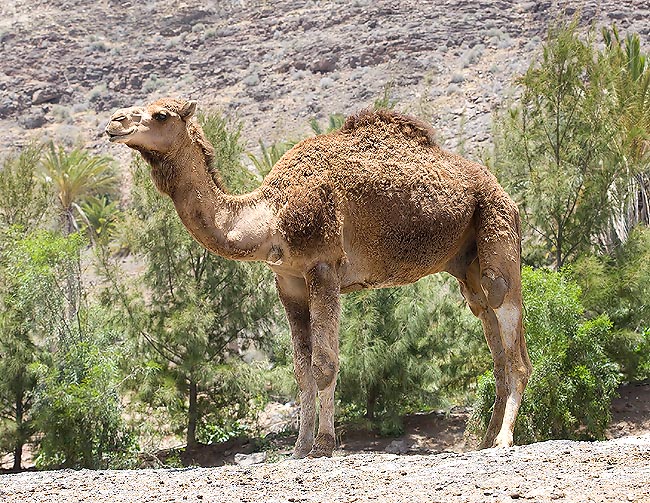
There are various dromedary races but the hair is always much shorter than the camel’s © Giuseppe Mazza
The capacity of the camels of surviving in the desert has been exploited by the man since very long time.
Nowadays, the only wild specimens are the two humped camels (Camelus bactrianus).
The Camelus dromedarius is little taller than the Camelus bactranius, but this one is stronger and more robust than the first one, and more suitable for the transportation of heavy weights, in the long desert caravans, such as of the Gobi and Tartar Deserts, whilst the dromedary is more utilized in Saharan Africa and in Middle East, by indigenous peoples such as the Tuaregs and the Bedouins.
The most known present domestic races come from very old breeding, as already in prehistoric times the camel was a invaluable aid for crossing the desert, and, later on, also for the trade of the goods and therefore of the commerce.
The “Silk Road” which includes the crossing of the Gobi Desert, in northern Chine, is an example of this, as it was well reported by Marco Polo in his legendary book “Il Milione” and for the Bedouins the dromedary still plays a key role in the trade.
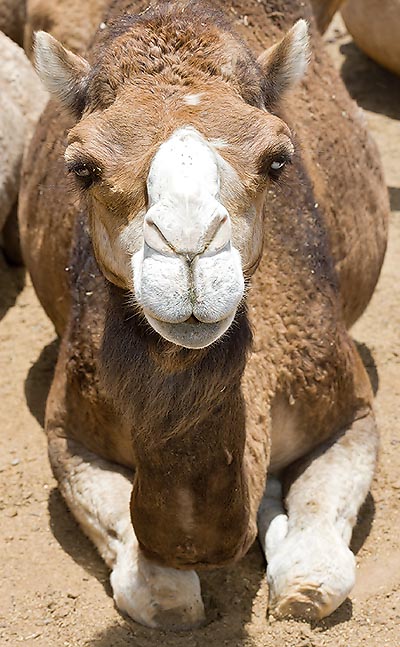
The coat may be fawn, white, reddish or piebald © Giuseppe Mazza
In our times, both in Africa (for instance, with the tribe of the Dorobo-Masai between Kenya and Tanzania, tribes of shepherds which also breed the dromedaries) and in Asia (for instance, the Bactrian camels utilized by the Mongolians in their country villages, but also in the villages of the populations of the Kazakhstan), these animals are bred in herds for the milk, the flesh and the fur, besides being utilized as burden beasts.
A curiosity is that both the Camelus dromedarius and the Camelus bactrianus do not need to be milked every day, like a milch cow, but only when the mother is nursing the cub, therefore having more than one mother with cubs being nursed at the same time is quite useful for the village shepherd who may milk them, for his own convenience little before the mother begins nursing the son.
Zoogeography
The Dromedary or One hump camel, or Arabian domestic camel (Camelus dromedarius) is autochthonous of North Africa in all the Sahara and in Asia Minor.
Habitat-Ecology
Extremophilic environments, arid, steppe and desert, where they have perfectly adapted to unbelievable temperatures. In the Sahara, in fact, we may reach temperatures of 60 °C, with temperature ranges which can reach the 60 °C between the day and the night. Here the dromedaries feel at home, between gigantic “ergs”, dunes as high as even 200 m, which they climb with a surprising agility and facility, what has given them the name of “vessel of the desert”. But we find it also in North Africa (Morocco, Tunisia, Algeria and Egypt), where, besides the vast areas of Sahara, exist also arid and stony zones, like the Moroccan Atlas.
Morpho-physiology
The Dromedaries (Camelus dromedarius), have long and slender legs which render them less robust than the Camelus bactrianus, for this reason they are utilized preferably as animal for transporting persons, for mounting and also for running events, typical of the Tuaregs and Bedouins in the deserts of North Africa. They have a shorter hair and a slight down around and under the neck, the single hump is in central position on the back, the colouration is hazel with darker shades of fawn, but there are totally white or reddish specimens.
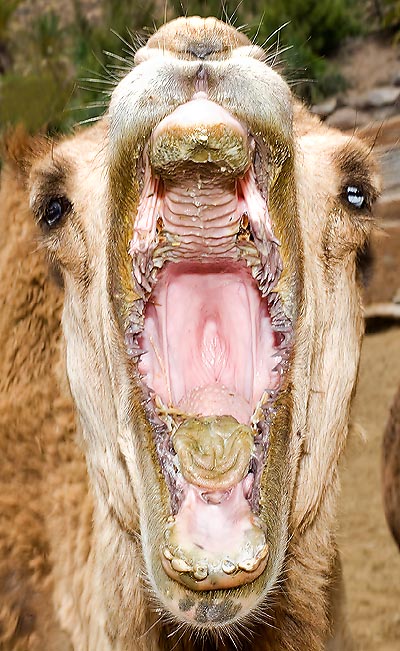
Mouth anatomy of a Camelys dromedarius © Giuseppe Mazza
The long eyelashes, as well as the voluntary muscles which can close the wide nares, protect the animal from the sand, and the pad which unites the toes (convergent characteristic of the members of the suborder Tylopodia) facilitates their placing on the sand, preventing them from sinking.
The snout is long, typical, and similar to that of the llamas. The hump, unique, is bigger than the two of the camel and the tail may reach the 40-50 cm.
It has two more molars, in respect to the llama, in its dental system; the same has the formula: 1/1; 1/1; 3/3; 3/3; which means (see text Equus caballus for reading the dental formula), which have a total of 32 teeth, divided per type: 4 incisors, 4 canines, 12 premolars and 12 molars.
In the camel as well as in the dromedary, the teeth are “tubular” and are therefore classified as “tubulodentate”.
The Camelus dromedarius, measures 2,40 m from the soil up to the upper extremity of its single hump. It may reach, galloping for short distances, the 20 km/h, but the average speed, with burden, is of about 3,5 km/h.
The dromedaries do amble, which means that they lift the two feet on one side together, shifting the weight of the body, alternately, right and left.
Their adaptation to so much arid and hot habitats is guaranteed by the fact that they may stand, without drinking, fairly long periods of drought.
And this is due by the fact that practically they do not sweat, and therefore there is no loss of water: a successful strategy allowing them to seat calmly, without suffering, under the terrifying Saharan sun.
From the physiologic point of view, the strong variations of the body temperature are a useful mechanism for avoiding losses of water. The internal temperature of a dromedary devoid of water rises in fact along with the outer one (as if it was a poikilotherm). Then, by night, it goes down to 34 °C, and this delays its raise on the following day.
In terms of exchanged of heat, the fat is deposited in one only place, the hump, and the remaining body surface operates as a radiator dispersing the heat.
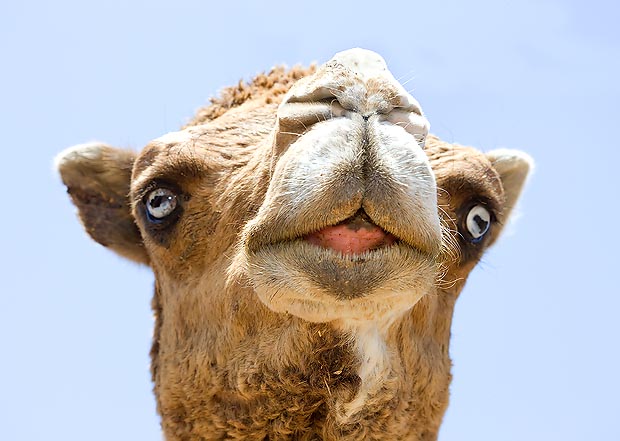
A male in love swells its typical pink mouth membrane for being noticed © Giuseppe Mazza
In the man, this easily penetrates through the skin and the adipose layer hinders its cooling. Only the evaporation through the sweat maintains the balance. But here, excepting the hump, there is no adipose layer, and they may, therefore, loose easily calories without wasting water in the sweat.
The rumour according to which the camel stores water in the hump or in the stomach is totally false!
The sacs of the first gastric compartment (called rumen) increase the glandular surface, but are not a reservoir of water.
Moreover, the stomach of the camel is divided in four parts, though two, the omasum and the abomasums are united to form one cavity only, which renders them as not classifiable as ruminants. In the rumen, in the reticulum and in the omasum, are digested the vegetal materials and the proteins are freed, in their turn scrapped in the abomasum, and the bolus then goes down to the small intestine for being absorbed.
The phase of the regurgitation in the mouth, typical of the ruminants like the cows, is therefore missing. Often a Camelus dromedarius by the end of a long trip in the desert, where it has not eaten or drunk, when it gets in an oasis, thin and thirsty, may drink in one time even 120 litres of water.
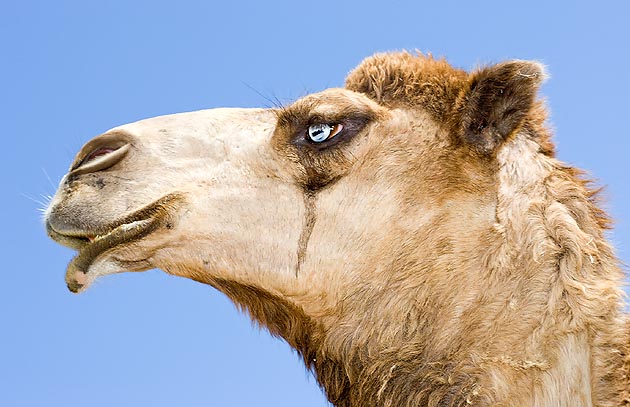
And, should not suffice, it growls and gurgles weeping at pheromones © Giuseppe Mazza
And this, with the nutrition, serves it for quickly recovering the lost weight. The red blood cells, of ovoid shape, then become spherical due to the absorption of the water. Even if they do not make a real reserve of water, the dromedaries are however very sparing in utilizing it after having drunk.
They eliminate less than one litre of urine per day, much concentrated, and begin to sweat and to loose water only when the environmental temperature exceeds the 40-50 °C!
In almost all the mammals, the cause of death by “hyperthermia” is the dehydration.
The blood loses the water, eliminated with the sweat, and become so much dense that it cannot circulate quickly enough for carrying the O2 to the vitals (brain and heart) and carrying to the skin, for its dispersion, the heat coming from the metabolic combustions.
Brain and heart suffer from hypoxia (low input of O2), the body thermal curve rises, because the skin cannot expel the heat and therefore the death occurs quickly!
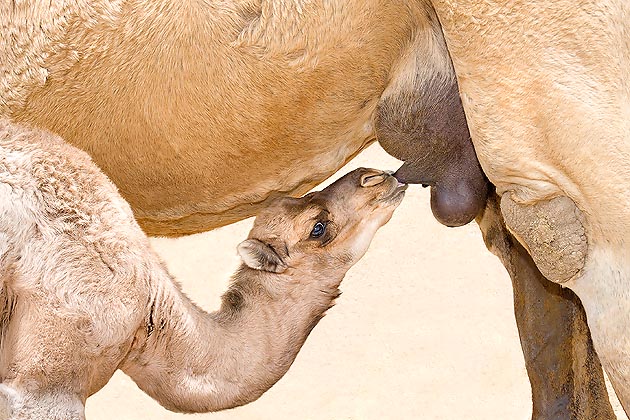
The nursing of Camelus dromedarius lasts 3-4 months © Giuseppe Mazza
In case of extreme dehydration, a man may lose even the 12% of his weight, and if he would ingest, all in one time, an equivalent quantity of water, he would die for water indigestion.
A dromedary which has lost the 30% of its body weight does not show, on the contrary, any sign of fatigue!
They get slim, but they can nourish and move, because the lost water was coming in great part from the tissues and not from the blood.
So, even when the body is dehydrated, the quantity and the composition of the blood keep unchanged, and this allows it to survive!
When they fill up of water, the blood red cells are able to stand this sudden dilution, because they are much numerous and may swell and absorb water without exploding (absence of haemolysis). And when the water passes from the blood to the tissues, the animal recovers its normal conditions. Usually, however, the dromedaries drink only the volume of water necessary for recovering their normal weight.
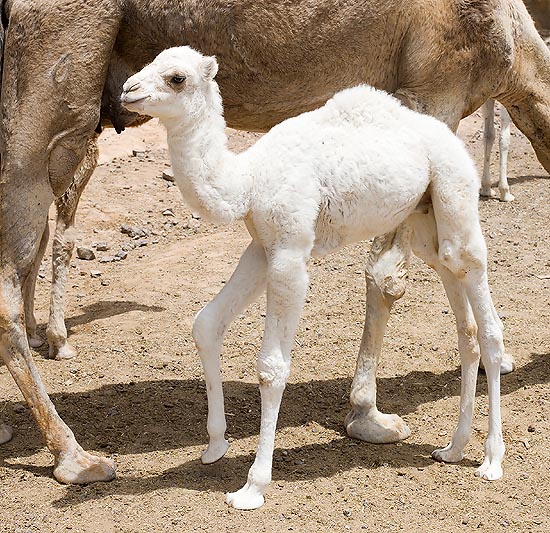
A just born white Camelus dromedarius © Giuseppe Mazza
In winter, when the plants are rich of water, they may avoid drinking; in summer, during the time when they do not drink during a travel, the dried plants will suffice.
Ethology-Reproductive Biology
The females come into oestrum and the males in heat; The couplings happen during the rain season.
A curious characteristic in the males is not only the lachrymation, a sort of “must” like that of the African elephant (Loxodonta africana even if in the pachyderms its role has not yet been totally clarified and in reality para-orbital and temporal glands are operating), which, for the truth, is present also outside the periods of heat, so much so that for the biologists there is not present the total conviction of a role associated to the sexual-reproductive aspect.
The grumbling-gurgling emitted by the males in heat and the swelling and the deflating of a pink membrane, which comes out from the mouth, assuming the conformation of a balloon, are however two odd and specific characteristics of sexual attractors.
These phenomena are stimulated by the presence of females in oestrum, due to the emission of their vaginal hormones and of their feminine pheromones.
Concluding, for stimulating the female to the coupling, the lingual balloon which comes out from the mouth, swelling and deflating alternately, should act as visual sexual attractor, the cries emitted by the male as acoustic sexual attractor and the lachrymation as “pheromone scent”.
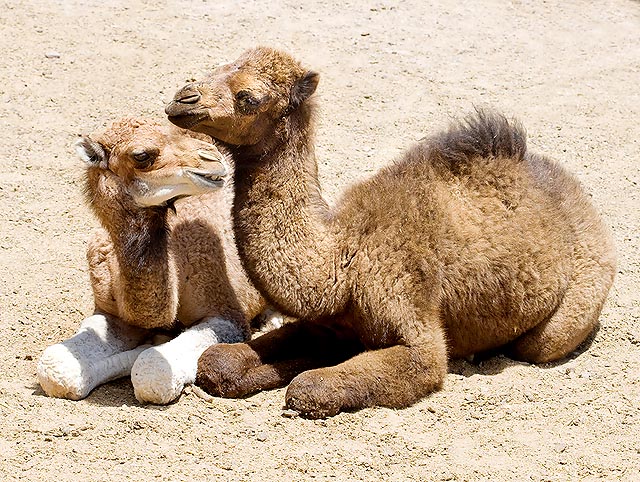
Two young and tender dromedary friends © Giuseppe Mazza
In the female the gestation lasts about one year. The deliveries are usually single and may be very difficult. The mothers nurse the cub for 3-4 months, but this last may follow them by itself walking already a few hours after the birth.
The IUCN has determined that certainly the Camelus dromedarius, as well as the Camelus bactrianus are not facing, for now, dangers of extinction, on the contrary, in some geographic areas where they have been introduced in the seventies of last century, they have escaped domestication, reproducing quite well, so much to create very numerous populations which compete for the food with the other tamed ungulates, exploiting their pastures in a territory by itself already arid, reason why the Australian Government has been obliged to kill many heads.
→ For general information about ARTIODACTYLA please click here.
